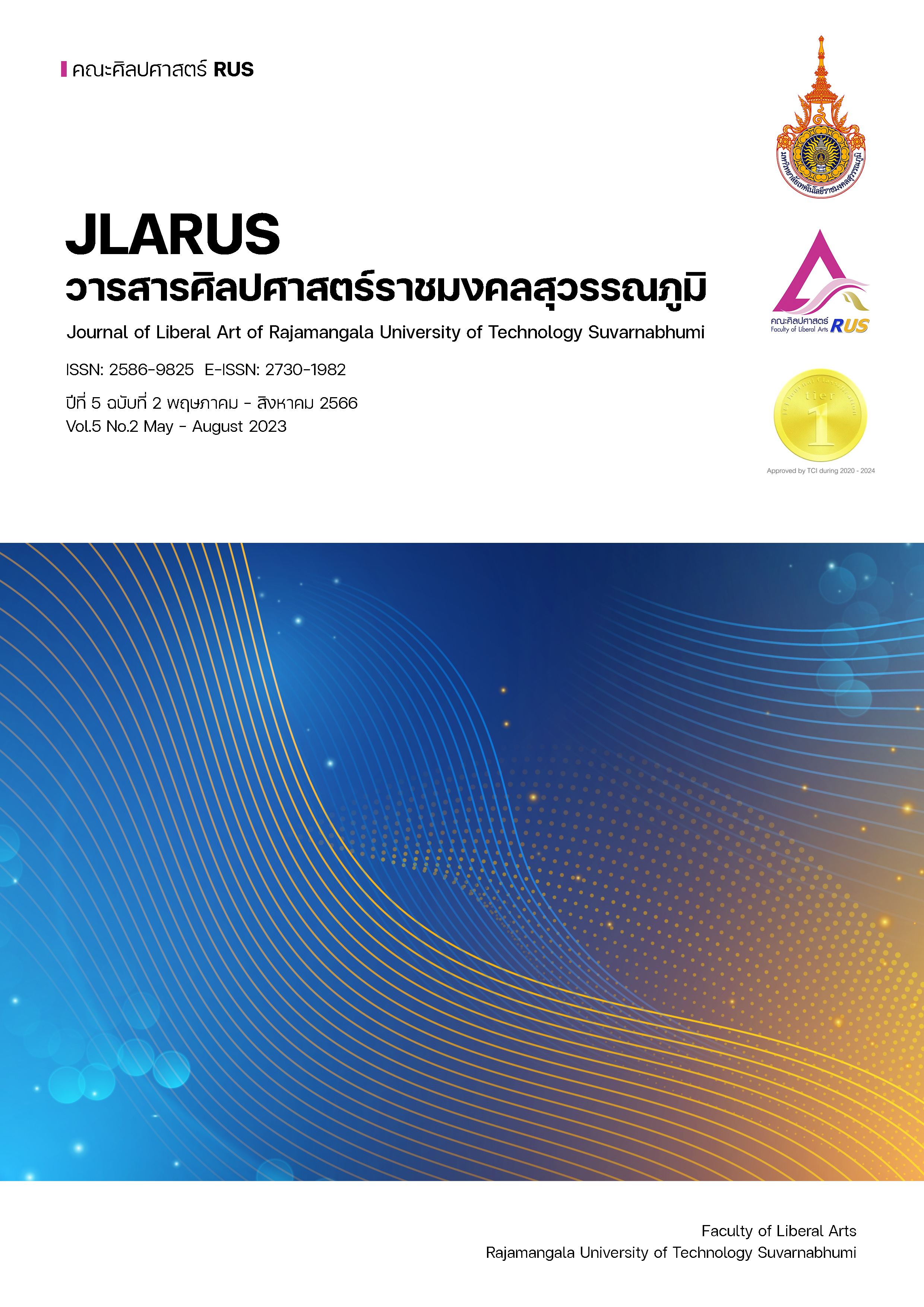PERSONAL FINANCIAL PLANNING FOR EACH SPAN OF AGE WITH PROJECTIVE TECHNIQUE
Main Article Content
Abstract
The aims of this research were; 1) to study the impact for span of age on personal financial planning behavior; 2) to study behavioral characteristics of personal financial planning in each span of age. It was a mixed method research, the sample consisted of 500 people living in 8 provinces in the upper northern region by using accidental sampling. The quantitative research sample consisted of 400 people, and data were collected from questionnaires and used multiple regression statistics to find the impact for span of age range on personal financial planning behavior. The qualitative research sample consisted of 100 people used the projective technique by a cartoon test for collecting data and analyzed the data by using the content analysis. The quantitative research results investigated that each span of ages had a positive effect personal financial planning behavior. The start working age (22-30 years old) paid more attention to income management of personal financial planning. The family building age (31-40 years old) emphasized determined financial goals, and savings of personal financial planning. The stable working age (41-55 years old) focused on liability management of personal financial planning and total of personal financial. The retirement age (over 55 years old) concerned more about expense management in personal financial planning. Moreover, the results of qualitative research can be confirmed that each span age range had different personal financial planning behaviors.
Article Details

This work is licensed under a Creative Commons Attribution-NonCommercial-NoDerivatives 4.0 International License.
References
กษวรรณ ขจรเสรี. (2560). การวางแผนทางการเงินก่อนเกษียณอายุ. วารสารมนุษยศาสตร์และสังคมศาสตร์ มหาวิทยาลัยเอเชียอาคเนย์. 1(1), 40-47.
กิตติพัฒน์ แสนทวีสุข. (2556). เงินทองต้องใส่ใจ. กรุงเทพมหานคร: ตลาดหลักทรัพย์แห่งประเทศไทย.
ฉัตรฤดี ศิริลำดวน สุภัตราภรณ์ สายสมบูรณ์ และนรา หัตถสิน. (2563). คู่มือการวางแผนการเงิน. อุบลราชธานี: มหาวิทยาลัยอุบลราชธานี.
ชาลิสา พุกกะรัตน์. (2562). การศึกษาความคิดเห็นและทัศนคติทางการเงินที่มีผลต่อการยอมรับความเสี่ยงส่วนบุคคลของประชาชนในเขตกรุงเทพมหานคร. วารสารสถาบันเทคโนโลยีไทย-ญี่ปุ่น. 7(1), 10-18.
ธนานพ ลิ่มสุวรรณโรจน์. (2562). การวางแผนการเงินของนักเรียนมัธยมปลายในกรุงเทพมหานคร. สถาบันบัณฑิตพัฒนบริหารศาสตร์, คณะสถิติประยุกต์.
นพรัตน ศรีศุภภัค และคณะ. (2560). กลยุทธ์การจัดสรรการลงทุนในสินทรัพย์ และกลยุทธ์การลงทุนแบบโมเมนตัมอุตสาหกรรม สำหรับการวางแผนการลงทุนเพื่อเกษียณอายุ. วารสารสุทธิปริทัศน์ 31(98), 1-16.
นิธิภักดิ์ กทิศาสตร์ และประภาพร กิจดำรงธรรม. (2562). ทัศนคติต่อการซื้อขายหุ้น โดยเทคนิคการสร้างภาพ กรณีศึกษาจากนักลงทุนรายย่อยในประเทศไทย. วารสารมหาวิทยาลัยราชภัฏมหาสารคาม. 13(3), 223-230.
พัฒนี ทองพึง. (2555). การวางแผนทางการเงินส่วนบุคคล: กรณีศึกษาเฉพาะครูโรงเรียนสังกัด
กรุงเทพมหานคร: มหาวิทยาลัยธุรกิจบัณฑิตย์.
พิราวรรณ จิระนันทราพร. (2555). ทัศนคติของประชาชนวัยทำงานในภาคเหนือของประเทศไทยต่อการวางแผนการเงินส่วนบุคคล (วิทยานิพนธ์ปริญญามหาบัณฑิต). มหาวิทยาลัยเชียงใหม่, เชียงใหม่.
รสชงพร โกมลเสวิน. (2562). เอกสารการสอนชุดวิชา หลักการประชาสัมพันธ์และโฆษณา (พิมพ์ครั้งที่ 3). สํานักพิมพ์มหาวิทยาลัยสุโขทัยธรรมธิราช.
วราลักษณ์ ลิ่มกาญจนา และคณะ. (2563). ปัจจัยที่มีอิทธิพลต่อพฤติกรรมการออมเพื่อเตรียมความพร้อมทางการเงิน เพื่อวัยเกษียณ: กรณีศึกษาพนักงานธนาคารพัฒนาวิสาหกิจขนาดกลาง และขนาดย่อมแห่งประเทศไทย ภาคใต้. วารสารวิชาการมหาวิทยาลัยกรุงเทพ. 19 (2), 28-45.
วิไล เอื้อปิยฉัตร. (2556). ความรู้ทางการเงิน: ตัวกำหนดและผลกระทบที่มีต่อพฤติกรรมการออม. ภาควิชาเศรษฐศาสตร์ คณะมนุษยศาสตร์และสังคมศาสตร์. บัณฑิตวิทยาลัย: มหาวิทยาลัยบูรพา
ศิริกุล ตุลาสมบัติ. (2562). แนวทางการจัดการการ เงินโดยใช้ระบบสารสนเทศของกลุ่มผู้ผลิตเต้าเจี้ยว อินทรีย์. วารสารการจัดการสมัยใหม่. 17(2), 25-36.
สมบูรณ์ สารพัด, ศิรินุช อินละคร และ ชไมพร ชินโชติ. (2564). การวางแผนการเงินส่วนบุคคลของประชากรวัยทำงานในจังหวัดชลบุรี. Journal of Roi Kaensarn Academi. 7(3), 218-234.
สุดารัตน์ ทิพาพงศ์. (2564). แนวทางการวางแผนทางการเงินเพื่อคุณภาพชีวิตวัยเกษียณอายุ. วารสารการบริหารนิติบุคคลและนวัตกรรมท้องถิ่น. 7(5), 353-365.
สุทธินันทน์ พรหมสุวรรณ. (2563) การศึกษาความแตกต่างของลักษณะส่วนบุคคล และอิทธิพลของการรับรู้ความเสี่ยงเกี่ยวกับการลงทุนและพฤติกรรมความเสี่ยงในการลงทุนที่มีต่อการวางแผนการลงทุนกองทุน Super Savings Fund (SSF) ของกลุ่มพนักงานบริษัทเอกชนในเขตกรุงเทพมหานคร. วารสารบัณฑิตศึกษา มหาวิทยาลัยราชภัฏวไลยอลงกรณ์ในพระบรมราชูปถัมภ์. 14(3), 180-193.
เอก ชุณหชัชราชัย. (2563). การศึกษาปัจจัยที่มีผลต่อการตัดสินใจเลือกวางแผนทางการเงินส่วนบุคคลของกลุ่มคนที่เพิ่งเริ่มต้นการทำงานในกรุงเทพมหานคร. วารสารวิชาการสมาคมสถาบันอุดมศึกษาเอกชนแห่งประเทศไทย. 26(2), 13-23.
Altfest, L. (2007). Personal financial planning. New York: McGraw-Hill Higher Education.
Bateson, P. (2017). Behavior, development and evolution. Cambridge, UK: Open Book Publishers.
Cascio, W. F. (2015). Industrial–organizational psychology: Science and practice. International Encyclopedia of the Social & Behavioral Sciences. 879–884.
Coile. (2015). Financial Factors Affecting Retirement Planning by Savings and Credit Cooperative Employees in Nakuru Town, Kenya. The International Journal of Business & Management, 5, 131–149.
Creswel, J. W. (2015). A concise Introduction to Mixed method Research. Los Angeles: Sage.
Donoghue, S. (2000). Projective techniques in consumer research. Journal of Family Ecology and Consumer Science. 28, 47-53.
Glenn, M. & Mary, W. (2013). Personal Financial Management Education: An Alternative Paradigm. Journal of Financial Counseling and Planning. 15(2), 79-88.
Hershey, D. A., Jacobs-Lawson, J. M., & Austin, J. T. (2013). Effective financial planning for retirement. Oxford, NY: Oxford University Press.
Hila, A. (2018). Early retirement and late retirement: Comparative analysis of 20
european countries. International Journal of Sociology. 48(3), 231-250.
Hinkle, D.E. (1998). Applied Statistics for the Behavioral Sciences. Boston: Houghton Mifflin.
Kapoor, J. R., Dlabay, L. R., & Hughes, R. J. (2009). Personal finance. (9th ed.). New York: McGraw-Hill Irwin.
Kline, R.B. (2016). Methodology in the Social Sciences. Principles and Practice of Structural Equation Modeling. 4 nd ed. [n.p.]: Guilford Press.
Levy, P. E. (2010). Industrial/organizational psychology: Understanding the workplace. (3rd ed.). New York: Worth Publishers.
Lunceford, G. M. (2017). What is retirement in the 21st Century? Cleveland, OH: Case Western Reserve University Press.
Marcinkiewicz, E. (2017). Factors affecting the development of voluntary pension schemes in CEE countries: A panel data analysis. Central European Economic Journal. 3(50), 26-40.
Miller, S. D., Duncan, B. L., Brown, J., Sparks, J. & Cloud, D. (2003). The outcome rating scale: A preliminary study of the reliability, validity, and feasibility of a brief visual analog measure. Journal of a Brief Therapy, 2(2), 91-100.
Murphy, D. S., & Yetmar, S. (2010). Personal financial planning attitudes: a preliminary study of graduate students. Management Research Review, 33(8), 811-817.
Petison, P. (2015). A comparison of three projective techniques: Lessons learned from a business research class. the International Journal of Applied Business and Economics Research. 13(6), 4519-4528.
Stienman, B. R. (2008). Projective techniques in consumer research, Northeastern Association of Business, Economics, and Technology Proceedings, 53-261.
Seidman, I. (2012). Interviewing as qualitative research: A guide for researchers in education and the social sciences (4th ed.). New York, NY: Teachers College Press.
Susan, M. & Djajadikerta, H. (2017). Understanding Financial Knowledge, Financial Attitude, and Financial Behavior of College Students in Indonesia. Advanced Science Letters. 23(9), 8762-8765.
Ng, Y. H., Tay, W. Y., Tan, N. L. & Lim Y. S. (2011). Influence of Investment Experience and Demographic Factors on Retirement Planning Intention. International Journal of Business and Management. 6(2), 196-203.
Yamane, Taro. (1973). Statistics: An Introductory Analysis. 3rded. New York: Harper and Row Publications.


